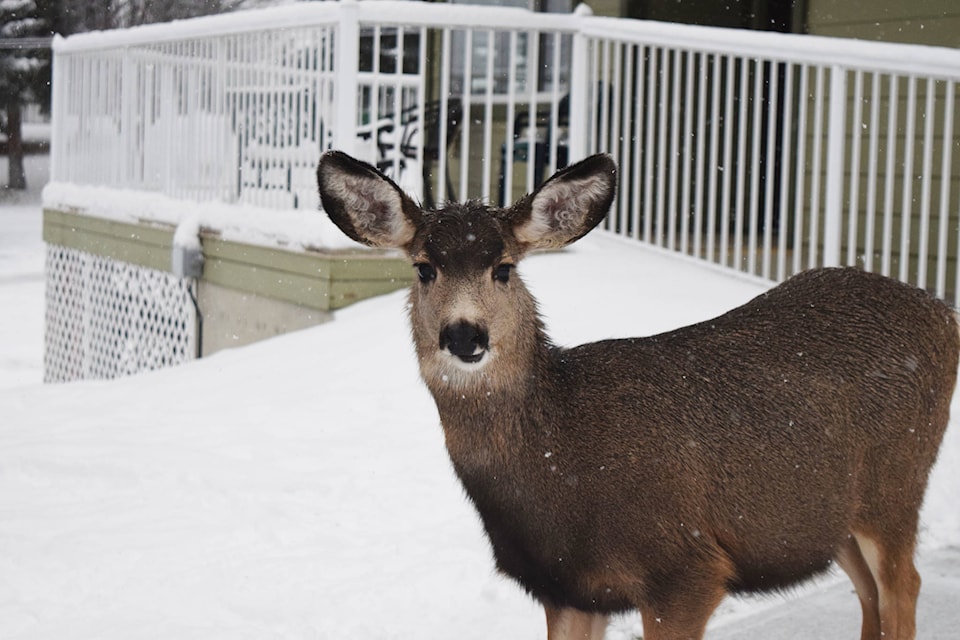Kimberley City Council has voted not to translocate any deer this year, after a recommendation from the Kimberley Urban Deer Advisory Committee (UDAC) came forward suggesting that 40 does and fawns be translocated this spring.
At a regular Council meeting on Monday, Council discussed the recommendation from the committee.
READ MORE: Kimberley deer committee recommends 40 deer be translocated this year
City CAO Scott Sommerville explained in a report to Council that this year’s annual deer count resulted in 77 deer being counted, with concentrations highest in the Marysville, Upper Chapman Camp and Townsite neighbourhoods. Last year’s count was 158.
“In prior years, the Managing for the Future document set 125 deer as the threshold for the City to act on reducing mule deer populations. In June of 2018 this threshold was lowered by the deer committee to 30 mule deer within city limits,” wrote Sommerville.
The City received several letters this week, both from residents and the Animal Alliance of Canada, stating that they are opposed to the translocation.
Mayor Don McCormick, Councillors Kyle Dalum, Darryl Oakley and Jason McBain voted for the motion not to translocate, while Councillors Sandra Roberts, Nigel Kitto and Kent Goodwin voted against.
McCormick says the City needs to be consistent with the “message they are sending” when it comes to deer populations, specifically based on the original number that the deer committee set out in 2010.
“We’ve spent, since 2010, roughly eight or nine years now communicating to the community expectations for how we deal with urban deer. We have set an expectation over those years that as long as we don’t have over 125 deer, all is well.”
He adds that the expectations from the Ministry of Forests Lands, Natural Resource Operations and Rural Development (FLNRORD) are “unreasonable” when it comes to dealing with deer that end up in another community.
“In order for Kimberley to get a license for translocation they [FLNRORD] are putting completely unreasonable and unacceptable terms inside that license, which calls for us to be responsible for any deer that are translocated and end up in other communities. It’s a slippery slope,” said the Mayor. “If we’re taking responsibility [for those deer], where does that stop? Despite the fact that translocation has been successful, there’s just too many issues with us taking on that responsibility.”
READ MORE: Kimberley to deal with translocated deer that migrated to Canal Flats
Councillor Kent Goodwin, who is Chair of the UDAC, said he “completely disagrees”, stating that the City is just now bringing the population of deer in town down to a manageable number. He says that if the City gets the number of deer down to 30, it will require less effort and spending for translocation in years to come.
“If we take our foot off the gas now, we’ll have another growth in population,” said Goodwin. “I think it’s best from both the deer and the public safety perspective. Deer should live in the wild, that’s their natural habitat.”
Councillor Sandra Roberts stated that the number in the managing for the future document was changed from 125 to 30 deer based on recommendations from experts including Vast Resources, Conservation Officers and other members of the deer committee.
“No one has ever played around with the figure until this June, when these experts decided so. We should support whatever they say,” Roberts said.
Sommerville pointed out that at the most recent deer committee meeting, a representative from FLNRORD was opposed to the recommendation of 30 deer as the target population.
Councillor Jason McBain suggested auditing that number further to see if it accurately reflects the level of social tolerance for the community.
READ MORE: What to do(e) with deer urbanites
Councillor Kyle Dalum agreed, saying that the number needs to be refined, however he adds that from a public safety perspective, deer should be in the wild.
“What benefit do the deer actually serve? I don’t see how any urbanized animal that should be in the wild can be good in any way… We need to keep an eye on public safety,” he said.
Councillor Darryl Oakley, who also sits on the deer committee, says that translocation is effective, however he agrees with Mayor McCormick that it shouldn’t be Kimberley’s responsibility to deal with deer that end up in other communities.
“The translocation works fine, 75 per cent of the deer carry on their lives elsewhere,” he said. “The real issue here is the translocation process. We’re being downloaded on by FLNRORD. It should be their responsibility when deer end up in another community.”
McCormick says that he, along with local Members of Parliament, will be addressing this issue to the Ministry this year. He adds that if translocation wasn’t originally set out as an experiment, it would have never been possible in the first place.
corey.bullock@kimberleybulletin.com
Like us on Facebook and follow us on Twitter
